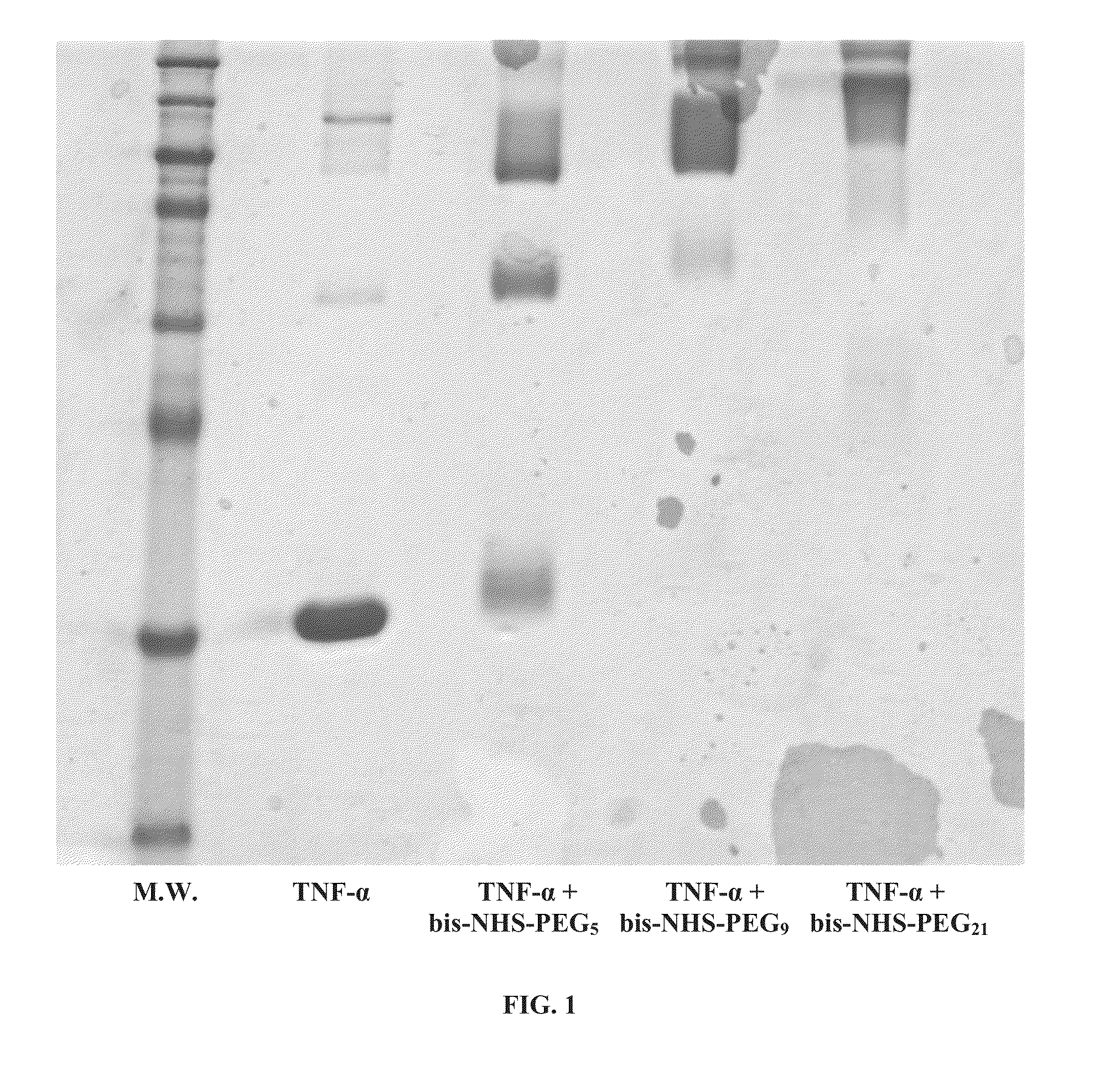Multimeric forms of therapeutic proteins and uses thereof
a multi-protein, protein technology, applied in the field of new drugs, can solve the problems of inactiveness, reduced activity, and/or less stability of the monomeric form of the drug,
- Summary
- Abstract
- Description
- Claims
- Application Information
AI Technical Summary
Problems solved by technology
Method used
Image
Examples
example 1
Effect of Cross-Linking on Activity and Stability of TNF-α
[0329]TNF-α was reacted with bis-N-hydroxysuccinimide-poly(ethylene glycol) (bis-NHS-PEG) cross-linking reagents. In order to assess the effect of cross-linker length, bis-NHS-PEG reagents of various lengths (bis-NHS-PEG5, bis-NHS-PEG9, bis-NHS-PEG21) were used.
[0330]For each reaction, 100 molar equivalents of the bis-NHS-PEG in 2 μl DMSO were added to 20 μg of human TNF-α in 20 μl of phosphate buffer (pH 8). The reaction mixture was kept at room temperature for 2 hours. The reaction products were then analyzed by SDS-PAGE analysis.
[0331]As shown in FIG. 1, native TNF-α existed primarily in a monomeric form under the SDS-PAGE conditions, whereas TNF-α cross-linked with bis-NHS-PEG existed primarily in a trimeric form. As further shown therein, reaction with bis-NHS-PEG increased the molecular weight of the TNF-α.
[0332]These results indicate that the TNF-α was covalently cross-linked by each of the tested bis-NHS-PEG species.
[...
example 2
Cross-Linked Luteinizing Hormone
[0341]Luteinizing hormone is reacted with bis-N-hydroxysuccinimide-poly(ethylene glycol) (bis-NHS-PEG) cross-linking reagents of various lengths (e.g., bis-NHS-PEG5, bis-NHS-PEG9, bis-NHS-PEG21, 2 KDa bis-NHS-PEG, 3 KDa bis-NHS-PEG, 6 KDa bis-NHS-PEG).
[0342]For each reaction, bis-NHS-PEG in DMSO is added to a buffered (e.g., pH 8) solution (e.g., aqueous solution) of luteinizing hormone. The reaction mixture is kept at room temperature for approximately 2 hours.
[0343]The reaction products are optionally then analyzed by SDS-PAGE analysis (e.g., using standard procedures), in order to determine the number of monomers in the cross-linked luteinizing hormone (e.g., so as to ascertain that a covalently bound multimeric structure is obtained), and / or in order to ascertain that the molecular weight of the monomers is increased (indicating attachment of the cross-linker to the protein).
[0344]The biological activity of the cross-linked luteinizing hormone is ...
example 3
Cross-Linked Immunoglobin
[0346]An immunoglobin which recognizes a selected target (e.g., a B-cell, TNF-α, HER2) is produced and purified as a monoclonal antibody using standard techniques (e.g., hybridoma cell technology).
[0347]The immunoglobin is then reacted with bis-N-hydroxysuccinimide-poly(ethylene glycol) (bis-NHS-PEG) cross-linking reagents of various lengths (e.g., bis-NHS-PEG5, bis-NHS-PEG9, bis-NHS-PEG21, 2 KDa bis-NHS-PEG, 3 KDa bis-NHS-PEG, 6 KDa bis-NHS-PEG).
[0348]For each reaction, bis-NHS-PEG in DMSO is added to a buffered (e.g., pH 8) solution (e.g., aqueous solution) of the immunoglobin. The reaction mixture is kept at room temperature for approximately 2 hours.
[0349]The reaction products are optionally then analyzed by SDS-PAGE analysis (e.g., using standard procedures), in order to determine the number of immunoglobin chains and / or domains in the cross-linked immunoglobin (e.g., so as to ascertain that a covalently bound multimeric structure is obtained), and / or i...
PUM
| Property | Measurement | Unit |
|---|---|---|
| elimination half life | aaaaa | aaaaa |
| structure | aaaaa | aaaaa |
| covalent | aaaaa | aaaaa |
Abstract
Description
Claims
Application Information
 Login to View More
Login to View More - R&D
- Intellectual Property
- Life Sciences
- Materials
- Tech Scout
- Unparalleled Data Quality
- Higher Quality Content
- 60% Fewer Hallucinations
Browse by: Latest US Patents, China's latest patents, Technical Efficacy Thesaurus, Application Domain, Technology Topic, Popular Technical Reports.
© 2025 PatSnap. All rights reserved.Legal|Privacy policy|Modern Slavery Act Transparency Statement|Sitemap|About US| Contact US: help@patsnap.com


